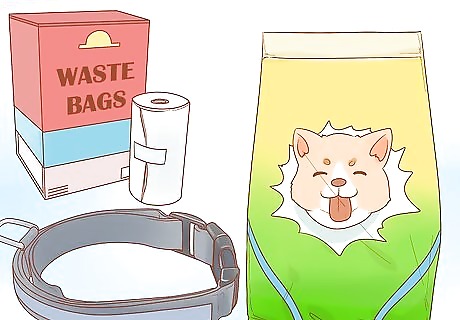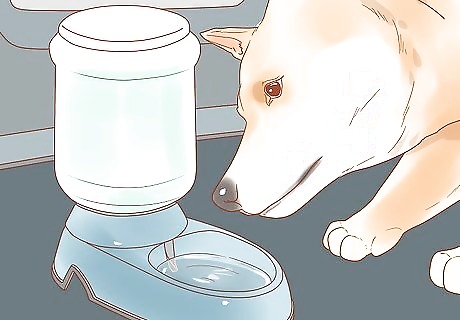
views
Preparing to Travel with Your Dog

Figure out how you want to restrain your dog in the car. It is not safe, nor advisable to let a dog roam around a car unrestrained. Consider putting your dog in a pet cage if you are driving a long distance or if your dog is a nervous passenger. It is the most effective way of keeping a dog still and under control whilst driving. Having a dog caged will help you to focus on driving instead of on the dog, which is important because distracted drivers can easily have accidents. It will also keep your dog safe if you have to stop quickly or if you get in an accident. If you don't want to cage your dog, at least find a way to make sure your dog is secure. For instance if you have an estate car, consider confining your dog to the rear of the car. If you do have a large window boot, put up a wire grid to stop your dog jumping over the back of the seats. Line the dog's area with dog blankets or place it's bed in the corner so it can nap comfortably on the journey. Make sure you don't have any heavy loose items, such as bowls or bottles, as those can become dangerous projectiles in an accident. Most dogs find sleeping an easy way to cope with motion sickness. You could also purchase a dog safety seat. While it is not as secure as a cage, it will be safer and more comfortable than a car seat for your dog if you turn or stop the car suddenly. The most popular among these are bucket seats. They attach at the back of the front seats, and the top of the back seats, creating a soft well in which your dog, and any liquids (or solids!) they may create, are contained. These can be made with a blanket or purchased cheaply. Car seatbelts for dogs are a great tool if you don't want your dogs confined, or if you only have a two-seater car. Make sure to attach them to a harness, and not a collar. They clip into the female buckle of a car seatbelt on one end, and have a standard lead clip on the other. By attaching them to a harness, you ensure the dog is secured by the body, and their neck won't be damaged in an emergency. If you use a cage, make sure it is secured. Make sure it is very secure to prevent it from moving if you stop suddenly or get hit. An unsecured cage can be just as, or even more dangerous than an unsecured dog.

Introduce your dog to the cage, if you are using one. Present the cage to your dog positively. Allow the dog to sniff the cage before it goes in the car. Once the cage is placed in the car, lock your dog in it. Continue your positive attitude about the cage and walk away from the dog in the cage for several minutes. Allow the dog to get into the cage itself by luring it with treats, and do not force the dog into the cage.

Exercise your dog before loading it into the car. You need to get your dog tired out before caging it. While a tired dog may still be upset about being caged, a fully rested dog will usually be even worse.

Avoid feeding your dog right before your trip. Feed him or her at least a few hours before. This will help your dog avoid getting carsick or doing it's business in the car, which is unpleasant for both owner and dog.

Pack appropriate supplies for your dog when embarking on a long car journey. Make the dog's area comfortable by placing it's bed or blankets down for padding. Also, bring water, treats, the dog's collar and lead, some of your dog's favorite chew toys, and plastic bags for poop.

Place a few chew toys in the back with your dog to keep your dog occupied. It is better not to give him or her a bone or food treats because if the dog feels sick it will bring it back up. Squeaky toys are also undesirable as they will drive you crazy.

Consult a vet if your dog shows signs of car sickness. Never medicate your dog with Dramamine or any other medication without the guidance of your vet. Your vet may have some other suggestions instead.

Address hyperactivity before the trip. If your dog has hyperactivity problems, contact your vet before the trip. See if a mild sedative is available and safe for your dog, especially if it is a long journey. Follow the dosing instructions carefully.
Going on a Long Drive with Your Dog

Let a puppy or new pet become accustomed to riding in a car gradually. Begin by allowing your dog to wander around your car with the engine off. Then start with short journeys until you and your dog become familiar with traveling by car together.

Make your first few trips in the car to somewhere fun for your dog. Don't go long distances right away, just get your dog used to the space. Take your dog to a park or a field so they associate a car journey with something good rather than just trips to the vet.

Keep your dog's collar on whenever you are driving long distance. There's always a chance, no matter how well-behaved your dog may be, that your dog will get out of the car and run away from you. Make sure that your dog can be identified if it escapes from you while traveling.

Take breaks. Let your dog run around and tire itself out. You should also give your dog a little snack and a little water while taking your break. Make sure that you stop every hour or so and go for a quick walk, even if it's only on the grass by a fast-food restaurant at a service station by the highway. This lets your dog go to the toilet, and gives you an ample opportunity to give your dog some water. Taking your dog on short walks is important as it means that the dog can stretch their legs and prevents it from getting bored. This is especially important if your going on a long journey. Four hours is your average dog's absolute limit for driving without a longer break, but as a driver it's recommended you take a break after every two hours of driving. Make sure you stop somewhere grassy and relatively quiet (not right beside the road), lock your car, feed your dog some food and water, and take him for a walk so he can let off some of his excess energy. If you stop by the highway your dog MUST be on a lead for his own safety.

Don't leave your dog in a parked car on a hot day. Be aware of how quickly a dog can get heatstroke, and die, in a parked car. To be safe, never leave your dog unattended in your car in warm weather for any length of time. If you stop for a meal, park your car in the shade, and let the windows down about an inch each to let cool air in. Put a bowl of cool water in the car for your dog and unbuckle him or her if in a dog seat. Lock your car doors, and order your food to go. Try to spend no more than five minutes away from the car if it is a warm day, as you don't want your dog to overheat. If your stop will take a bit longer, for instance you are waiting in a long queue for food, tie your dog to a post either just inside the front door or just outside in a place where you can see it. At least he or she will be out of the heat while you wait. Make sure to tie the dog with secure knots so it doesn't escape. Tight knots will also mean it will be less likely for someone to steal your dog.

Avoid comforting your dog if he or she is showing signs of distress. Comforting the dog, as natural as it seems, reinforces the idea that something bad is happening. Do your best to stay calm and normal while paying attention for signs of true distress (instead of discomfort).

Reward your dog once you get to your destination. Take it for a long walk immediately on arrival. Give it a treat, assure it, and give it lots of love for making through the journey.


















Comments
0 comment